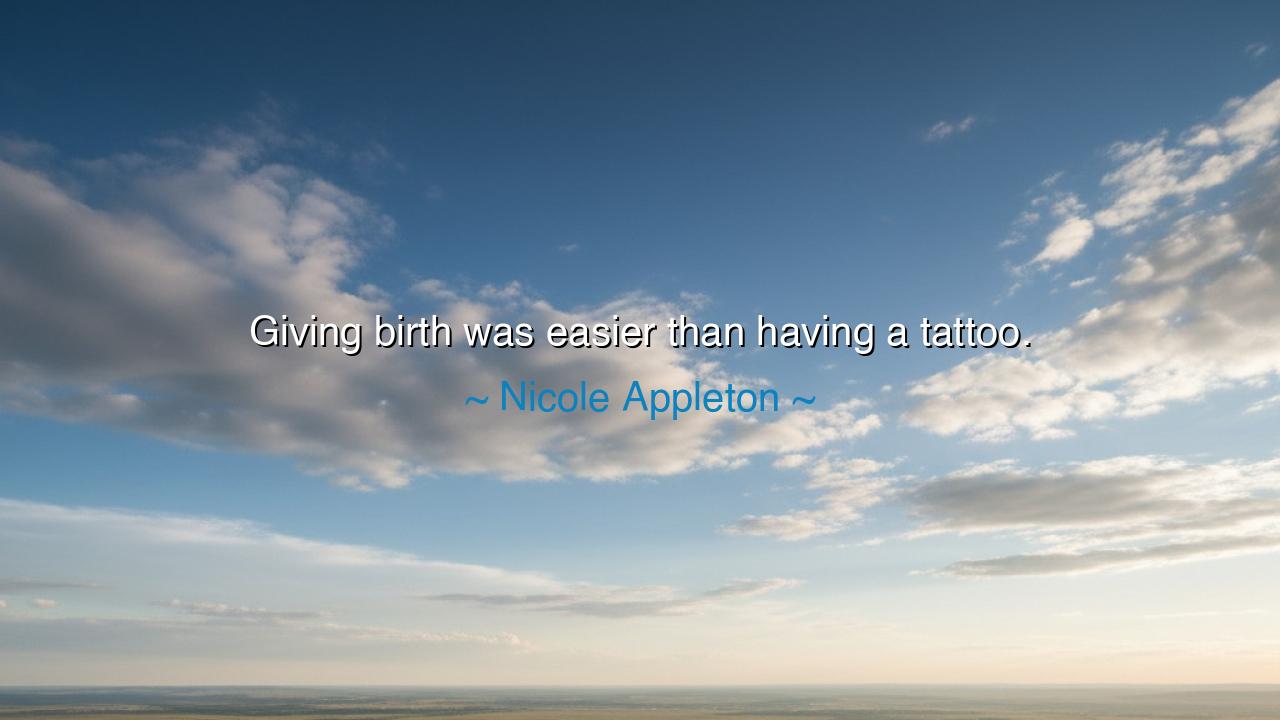
Giving birth was easier than having a tattoo.






In the words of Nicole Appleton, “Giving birth was easier than having a tattoo.”—a phrase both startling and profound, born of pain, endurance, and the strange balance between the physical and the spiritual. To the unhearing ear, it is but a jest; yet to the heart that listens deeply, it speaks of the paradox of strength and vulnerability that dwells within every soul who has endured the trials of life. For to give birth is not only to deliver life into the world, but also to surrender oneself to a force far greater than flesh, while to endure a tattoo is to invite pain by choice, to mark the body as a testament of memory and meaning.
The ancients would have said that all pain has its purpose, yet not all suffering bears equal weight. In childbirth, the pain is sanctified—pain that creates, pain that gives. It flows through a mother’s body as the river through the canyon, carving new paths of compassion and courage. But the pain of the needle—sharp, deliberate, self-inflicted—is pain that declares, pain that inscribes. It is the will of the self made visible upon the skin, a statement that one’s body is no longer only a vessel of birth and breath, but a canvas of identity, remembrance, and rebellion.
Long ago, among the tribes of the Polynesian isles, tattoos were sacred. Each mark, carved with bone and ink, told the story of lineage, courage, and passage. The chiefs bore their tatua as armor of honor; warriors endured the sting of the blade not for beauty, but for belonging. It was said that he who could endure the mark of fire without flinching was ready to lead his people. And so too, when Nicole Appleton spoke those words, she echoed an ancient truth—that endurance is not one kind alone. The pain of childbirth is nature’s test; the pain of self-marking is the spirit’s choice.
Yet the heart of her words lies not only in pain, but in perspective. She had walked through the valley of agony once to bring life, and once to adorn her own. To find the first easier is to reveal how deeply she has known the second—that sometimes, the wounds we choose are harder than those destiny demands of us. This is the lesson of those who have fought their inner battles: the soul’s chosen trials are sharper than fate’s decrees, for they spring not from necessity but from courage.
Consider the story of Frida Kahlo, the painter of passion and pain. Her body was a garden of suffering, her spine fractured, her heart broken by love and fate alike. Yet she chose to paint her anguish upon canvas, to make her torment bloom into art. Like Appleton’s tattoo, each stroke of Frida’s brush was a mark of defiance, a cry of ownership over pain. She transformed her suffering into a symbol of endurance—declaring through color and form, “This is mine. I will not be erased.”
So let this be the wisdom we pass down: that all who live must know pain, but the noblest souls are those who transform it. Whether the pain of childbirth, of loss, or of creation, let it forge you, not break you. Do not flee from the fire; walk through it, and let its ashes birth your new self. The mark you choose to carry—whether ink upon skin or scar upon spirit—is your testament to having lived bravely.
And when your time comes to face your own trial—when you must bear what seems unbearable, or choose the wound that will define you—remember the truth hidden in this jesting quote: that what seems small to others may test your whole being. Endure it with grace, and mark your life with meaning, not fear. For only those who embrace their chosen pain become masters of their destiny.
Thus, the teaching is clear: face your pain with purpose, and let no fear of discomfort keep you from expressing who you are. The body heals, but the soul endures—and it is the soul, marked with the ink of courage, that leaves a legacy worthy of remembrance.






AAdministratorAdministrator
Welcome, honored guests. Please leave a comment, we will respond soon